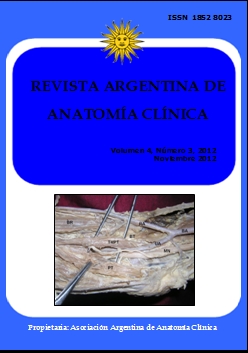ANATOMÍA DE LA LENGUA EN AL-QANUN DE AVICENA. Anatomy of the tongue in Al-Qanun of Avicenna
DOI:
https://doi.org/10.31051/1852.8023.v4.n3.14033Keywords:
Avicena, Al-Qanun, anatomía, lengua, Avicenna, anatomy, tongueAbstract
Objetivo: En esta revisión pretendemos resumir las aportaciones más destacadas de Avicena, incluidas en Al-Qanun, al campo de la anatomía lingual. Material y Metódos: Se realiza una revisión de varias ediciones en árabe y en persa del primer y segundo volumen de Al-Qanun, centrándonos en los capítulos correspon-dientes al estudio de la anatomía de la lengua e intentando relacionar los conceptos incluidos con los conocimientos actuales. Resultados: Al-Qanun de Avicena ofrece un claro ejemplo del avanzado nivel de comprensión de la anatomía de la lengua, como fueron percibidos hace más de mil años y de lo cual muchos conceptos siguen vigentes hasta la actualidad. Conclusión: El campo de la anatomía lingual es un claro ejemplo de la participación de la Medicina Islámica y de la contribución de los médicos musulmanes al desarrollo de la Anatomía. Las contribuciones científicas de los grandes maestros como Avicena a este campo no deben ser ignoradas.
Objective: The aim of this review is to summarize the most important contributions of Avicenna, included in Al-Qanun, to the study of the anatomy of the tongue. Material and methods: We made a review of several editions in Arabic and Persian of the first and the second volume of Al-Qanun, focusing on the chapters which study the anatomy of the tongue and trying to relate the concepts involved with the current knowledge. Results: Al-Qanun of Avicenna offers a clear example of the advanced level of understanding of anatomy of the tongue, as they were perceived since more than a thousand years, and which many concepts still apply to the present. Conclusion: The field of anatomy of the tongue is a clear example of the involvement of Islamic Medicine and the contribution of Muslim physicians in the evolution of Anatomy. The scientific contributions of the great masters, like Avicenna, in this field should not be ignored.
References
Abu Ali al-Shaykh al-Ra’is. 2008. Kitab Al Qanoun fi Al Toubb. Libro 2, tratado IV, capítulos 1-15. En: Typographia Medicea. Roma, Italia: Medical Press, pag: 354-60.
Afnan SM. 1958. Avicenna. His Life and Works. London: George Allen & Unwin Ltd, pag: 79.
Amber Haque. 2004. "Psychology from Islamic Perspective: Contributions of Early Muslim Scholars and Challenges to Contemporary Muslim Psychologists". Journal of Religion and Health 43: 357 - 377.
Azizi MH. 2000. Ibn-Sina, the greatest oriental physician. Med J Iranian Hospital 3: 70 – 71.
Gohlman WE. 1974. The Life of Ibn Sina. Albany, NY: State University of New York Press, pag: 130 -133.
Ibn Sina.1958. The Law in Medicine “Alkanoun” volumenes 1 y 3. Cairo: Ed. Bulak, pag 180.
Ibn Sina.1980. AlQanun fi t-tibb. Volumenes 1 y 3. Beirut: Ed. Dar Sader, pag: 470.
Ibn Sina. 1997. The Canon of Medicine. 4ª ed. Libro 2, Parte 1, Tehran: Soroush Press, pag: 274, 296 – 320.
Ullmann M. 1997. Islamic Medicine. UK: Edinburgh University Press, pag: 43 – 44.
Published
Issue
Section
License
Authors retain copyright and grant the journal right of first publication with the work simultaneously licensed under a Creative Commons Attribution License that allows others to share the work with an acknowledgement of the work's authorship and initial publication in this journal. Use restricted to non commercial purposes.
Once the manuscript has been accepted for publications, authors will sign a Copyright Transfer Agreement to let the “Asociación Argentina de Anatomía Clínica” (Argentine Association of Clinical Anatomy) to edit, publish and disseminate the contribution.



